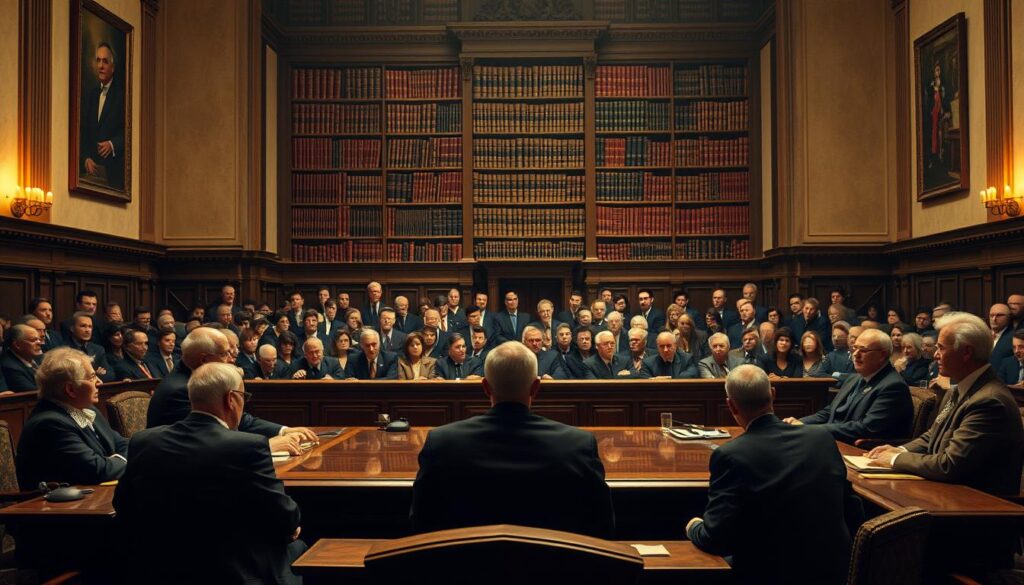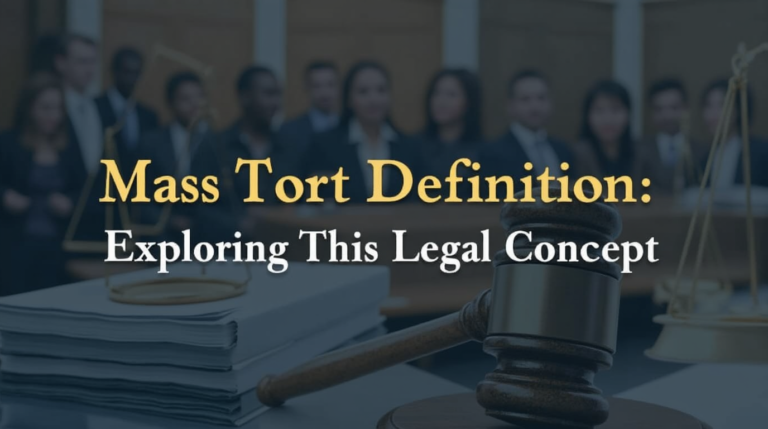When you face big legal problems with widespread harm, a mass tort lawsuit is a strong way to seek justice. It’s a legal strategy for many plaintiffs to file claims against one or more defendants. This is for similar damages from one wrong act.
Unlike regular lawsuits, a mass tort lawsuit sees each plaintiff’s story as unique. This lets each person get compensation based on their own situation. It makes sure everyone gets fair treatment and legal help that fits their case.
Mass tort lawsuits are key when many people get hurt in the same way. This could be from big companies, bad products, or general neglect. By joining together, plaintiffs can fight big defendants better and get fair payback.
Table of Contents
Understanding Mass Tort Litigation
Mass tort litigation is a key legal approach for dealing with widespread harm from one source. It lets many plaintiffs fight for justice together. They do this when they’ve all been hurt in the same way.

Mass tort claims are different from regular lawsuits. They let people join forces against big companies. At the same time, they can still get compensation for their own specific injuries.
Core Characteristics of Mass Tort Cases
Mass tort litigation has some key features:
- It involves hundreds or thousands of individual plaintiffs
- It targets large corporations or manufacturers
- It allows for individual claim variations
- It consolidates pretrial proceedings through Multidistrict Litigation (MDL)
Some common reasons for mass tort claims include:
- Defective pharmaceutical products
- Environmental contamination
- Dangerous medical devices
- Widespread corporate misconduct
Mass tort litigation empowers individuals to challenge systemic corporate negligence while preserving their unique legal narratives.
This legal strategy makes it cheaper for people to seek justice. By sharing costs, it lowers the financial hurdles. This makes complex legal battles more reachable for everyone.
Understanding Mass Tort Litigation
Mass tort litigation has changed the legal world. It helps address harm caused by big companies. This legal path shows a journey of justice and holding people accountable.

The start of mass tort litigation comes from important legal moments. These moments were in response to big injuries. They shaped how courts deal with many plaintiffs against big companies.
Landmark Moments in Mass Tort History
Some cases were key in mass tort litigation:
- The Vioxx recall in 2004, which led to a $5 billion settlement after heart attacks and strokes lawsuits
- Asbestos litigation that showed the dangers of industrial health risks
- Tobacco litigation that challenged corporate wrongdoing
These cases showed how mass tort litigation can make big companies answer for harm. Unlike single lawsuits, mass tort actions let plaintiffs join forces. This increases their chances of getting justice.
Evolution of Legal Strategies
Mass tort litigation has grown more complex. Courts now look at several things when deciding on mass tort actions. These include:
- How many plaintiffs are involved
- Where the injuries happened
- How similar the damages are
As companies get more complex, mass tort litigation keeps evolving. It’s a key way to protect people’s rights against big powers.
Understanding Mass Tort Litigation
Mass tort litigation is key in today’s legal world. It helps people fight big companies that cause harm to many. It lets individuals seek justice and get compensation for big injuries or damages.

This legal action does more than just help one person. It brings together similar cases. This makes the legal process more efficient and less expensive.
- Reduces overall litigation costs
- Increases legal process efficiency
- Allows individual plaintiffs to pursue justice
- Holds corporations accountable for harmful actions
Multidistrict Litigation: A Specialized Approach
Multidistrict litigation (MDL) is a smart way to handle big cases. It lets federal courts handle many similar lawsuits at once. This makes the process faster and fairer.
| Mass Tort Category | Typical Characteristics | Example Cases |
|---|---|---|
| Pharmaceutical Litigation | Drug-related injuries | Vioxx recalls (2004) |
| Product Liability | Defective consumer products | Medical device litigation |
| Environmental Torts | Large-scale environmental damage | Camp Lejeune water contamination |
Mass tort litigation helps people fight against big companies. It makes sure justice is fair, even when cases are complex.
Mass Tort Definition: Core Components and Features
Understanding the mass tort definition shows a complex legal setup. It’s designed to handle widespread harm from a single product or action. Product liability claims are at the heart of these cases. They let many plaintiffs fight against one defendant.
The main parts of mass tort lawsuits include:
- Many plaintiffs with similar injuries
- A single defendant who caused the harm
- Common facts or circumstances
- The chance for big financial wins
Mass tort cases involve many situations, like faulty medical devices or harmful drugs. These actions let people team up against corporate wrongdoings. They also make it cheaper for each person to fight in court.
| Mass Tort Category | Average Settlement Range | Notable Examples |
|---|---|---|
| Pharmaceutical Cases | $100,000 – $250,000 | Roundup® Cancer Claims |
| Medical Device Claims | $100,000 – $500,000 | IVC Filter Lawsuits |
| Chemical Exposure | $500,000 – $1,000,000 | Asbestos Mesothelioma Cases |
Knowing about mass torts helps you understand complex legal issues. It ensures justice for those hurt by big companies’ wrongdoings.
Legal Framework and Jurisdiction
Understanding mass tort lawsuits means knowing about legal areas. Where you choose to sue can change the case’s result. It’s key to know the differences between federal and state courts.

When you sue in a mass tort case, picking the right court is important. You need to think about several key points that can shape the case.
Key Considerations in Court Jurisdiction
Knowing about multidistrict litigation and where to sue is crucial. Here are the main things to consider:
- Where the defendants are located
- The type of legal claim
- Chances of winning based on past cases
- The complexity of the scientific evidence
- State versus federal court rules
Federal courts often deal with:
- Claims against products used across the country
- Pharmaceutical lawsuits
- Cases that affect many states
- Complex scientific or technical issues
State courts might be better for local injury claims or cases tied to a specific area. Your legal plan should look at these differences to get the best outcome.
The right jurisdiction can make a substantial difference in the outcome of your mass tort lawsuit.
Legal Framework and Jurisdiction
Understanding the world of mass tort claims is key. The multidistrict litigation (MDL) process helps manage cases across different places. It’s a powerful tool for federal courts.
Multidistrict litigation is crucial for handling complex cases. It brings together similar lawsuits from different courts. This makes the legal process smoother.
How Multidistrict Litigation Works
The MDL process moves related cases to one court. This has many benefits:
- Reduces duplicate discovery efforts
- Prevents conflicting pretrial rulings
- Increases judicial efficiency
- Saves time and resources for all parties involved
A special panel picks a court for pretrial work. This court handles important tasks like gathering evidence and settling cases.
Key Characteristics of MDL in Mass Tort Claims
Mass tort claims in MDL let each case be unique. But they also aim for fairness. Unlike class actions, where everyone gets the same, MDL allows for different damages.
The MDL process represents a strategic approach to managing complex litigation involving multiple plaintiffs and similar legal claims.
MDL centralizes complex cases. This makes resolving mass tort claims more efficient and fair.
Legal Framework and Jurisdiction
Understanding mass tort lawsuits is complex. You’ll face many steps to ensure fair treatment for those harmed by defective products.
Going after a mass tort lawsuit means following specific rules. These rules protect both sides. They help manage big cases with many people affected by the same issue.
Key Procedural Requirements
- Establishing clear commonality among plaintiff claims
- Documenting specific damages from defective products
- Proving substantial similarity in legal arguments
- Identifying a shared factual basis for litigation
Mass tort cases demand meticulous documentation and strategic legal approach to succeed.
To win in mass tort cases, you must show widespread harm. The courts need solid evidence. This evidence must show how a product or action hurt many people.
| Procedural Requirement | Details |
|---|---|
| Evidence Gathering | Collect medical records, expert testimonies, product documentation |
| Plaintiff Identification | Verify individual harm and connection to specific product |
| Legal Standard Proof | Demonstrate consistent pattern of negligence or product failure |
Recent data shows how complex mass tort claims can be. For example, over 900 reports of problems with IVC filters show the size of some cases. This makes multidistrict litigation (MDL) very important.
Types of Mass Tort Claims
Mass tort claims are a key way for people to fight against big companies that cause harm. These cases involve many people suing for injuries and damages. They cover a wide range of legal issues.
Knowing about different mass tort claims can help you see if you have a case. The main types include:
- Dangerous drugs litigation
- Defective medical device claims
- Consumer product liability
- Environmental exposure cases
- Toxic substance injuries
Many mass tort claims are about drugs and medical devices. For example, the 3M earplug case led to a $10.3 billion settlement for hearing loss in the military. Bayer also paid about $11 billion to settle lawsuits over Roundup’s cancer risks.
| Mass Tort Claim Type | Typical Characteristics | Notable Examples |
|---|---|---|
| Dangerous Drugs | Pharmaceutical products causing serious side effects | Roundup, Talcum Powder Litigation |
| Medical Device Failures | Defective implants or medical equipment | Hip Replacement Recalls |
| Environmental Torts | Toxic exposure leading to health complications | Groundwater Contamination Cases |
Mass tort claims offer a special way to tackle big problems. They’re different from class actions because they let each person have their own lawyer. But they also share some steps before going to court.
Key Elements of Mass Tort Cases
Mass tort lawsuits are a key way to handle widespread harm caused by one entity or action. They let many plaintiffs seek justice for similar injuries or damages.
At the heart of mass tort cases is the number of plaintiffs. Unlike single lawsuits, these cases unite many people harmed by the same thing. This could be due to environmental disasters or faulty products.
Understanding Multiple Plaintiffs in Mass Tort Litigation
The number of plaintiffs is key in mass tort lawsuits. These cases usually involve:
- Hundreds to thousands of individual plaintiffs
- Shared experiences of harm or injury
- Similar claims against a common defendant
The Bhopal disaster is a great example of mass tort litigation. It led to about 20,000 wrongful death claims and affected around 500,000 people due to a chemical leak.
Mass tort cases offer a strong legal path for groups to get compensation. This is especially true when individual lawsuits wouldn’t work well.
These lawsuits can cover many places, from New York to California. This lets affected people work together to get justice against the responsible parties.
Key Elements of Mass Tort Cases
Mass tort claims often focus on a key legal idea: the common defendant factor. This idea sets mass tort cases apart from single lawsuits. When many people get hurt by the same thing, they can sue together against one entity.
Big companies and makers of products are often at the center of mass tort cases. The shared defendant lets plaintiffs work together. They can share costs, make legal processes smoother, and take on big companies better.
Identifying the Common Defendant
To understand the common defendant factor, we look at a few important traits:
- A single company that causes harm to many
- A pattern of injuries linked to their products
- Strong evidence of their negligence
- The chance for big financial losses
Defective products lead to big legal battles. For example, the car industry has faced many mass tort cases over faulty parts. In 2014, over 34 million cars were recalled for airbag issues. This shows how big these cases can get.
Mass tort cases empower individuals to challenge corporate misconduct through collective legal action.
The size and legal power of the defendant are key in these cases. Big companies have strong legal teams and lots of money to fight these claims. This is why working together is crucial for plaintiffs to get justice.
Key Elements of Mass Tort Cases
Mass tort cases involve complex legal processes. They require understanding causation and liability. When many people are harmed by dangerous drugs or defective products, it’s key to show a clear link between the defendant’s actions and the injuries.
Understanding causation in mass tort cases needs thorough legal and scientific investigation. Plaintiffs must show a direct link between the harmful product and their injuries.
Proving Causation in Mass Tort Claims
Establishing causation involves several key components:
- Scientific evidence documenting product-related harm
- Expert medical testimony
- Detailed documentation of individual injuries
- Comprehensive analysis of product design and potential defects
“In mass tort litigation, the burden of proof rests on demonstrating a clear, scientifically validated connection between the product and the sustained injuries.”
Mass tort cases involving dangerous drugs need a lot of investigation. Plaintiffs must prove that the drug directly caused their health problems.
| Mass Tort Element | Key Requirement | Typical Evidence Needed |
|---|---|---|
| Causation | Direct product-injury link | Medical records, expert testimony |
| Liability | Manufacturer negligence | Design defects, failure to warn |
| Damages | Quantifiable harm | Medical expenses, lost wages |
Successful mass tort litigation needs strong evidence linking the defendant’s actions to the injuries. This requires a lot of scientific research, medical expertise, and legal analysis.
Mass Tort vs Class Action Lawsuits
When you’re dealing with legal claims involving multiple plaintiffs, you’ll encounter two main approaches. These are mass tort lawsuits and class action lawsuits. They might seem similar, but they have key differences. These differences can greatly affect your potential compensation and legal rights.
Mass tort lawsuits let each plaintiff fight their own case against a common defendant. Each person’s claim is unique, with compensation based on their specific damages and injuries. This way, you get personalized legal help and a chance for a settlement that fits your situation.
- Individual claims are evaluated separately
- Plaintiffs can negotiate individual settlements
- Economic damages cover specific out-of-pocket costs
Class action lawsuits, on the other hand, group all plaintiffs together. A single representative plaintiff speaks for the whole group. Any settlement or court award is then split among all class members. This method can be quicker for the court but might mean smaller payouts for each person.
- One representative plaintiff for the entire group
- Standardized compensation across plaintiffs
- Binding outcome for all class members
When deciding between a mass tort lawsuit or a class action, talk to an experienced attorney. They can look at your case and suggest the best legal path for you.
Proving Liability in Mass Tort Cases
Understanding mass tort claims is complex. It needs a detailed plan to collect and show evidence. Product liability cases require strong proof and science to prove fault.
- Medical records showing injuries
- Scientific studies and expert opinions
- Internal company documents
- Photos and physical evidence
- Testimonies from witnesses
Comprehensive Evidence Standards
Your legal plan must show four main points to prove liability in mass tort claims:
- Show the duty of care
- Prove the duty was broken
- Link the breach to the injury
- Show the extent of damages
| Evidence Type | Importance in Mass Tort Claims | Potential Impact |
|---|---|---|
| Medical Documentation | Proves direct injury correlation | High settlement potential |
| Expert Testimony | Validates scientific connections | Critical for complex cases |
| Corporate Records | Reveals potential negligence | Can trigger punitive damages |
Winning product liability cases needs strong, science-backed evidence. It must clearly show the defendant’s actions caused the injuries.
Proving Liability in Mass Tort Cases
Expert testimony is key in mass tort cases, especially in complex environmental disasters. In these cases, experts link defendant actions to plaintiff injuries. They are vital in the legal fight.
Experts bring specialized knowledge to the court. They explain technical details that lawyers might not fully grasp. Their testimony covers a wide range, from toxic exposures to faulty medical devices.
Experts must have strong credentials and give clear, scientific explanations. They show how defendant actions caused harm to plaintiffs. Courts look closely at their qualifications, methods, and the science behind their findings.
In cases of environmental disasters, experts analyze complex data. They show how corporate actions led to health problems. A good legal team finds experts who can make complex science easy to understand.
Attorneys look for experts with deep knowledge and clear communication skills. Their testimony turns complex evidence into strong arguments. This helps judges and juries grasp the details of mass tort cases.

